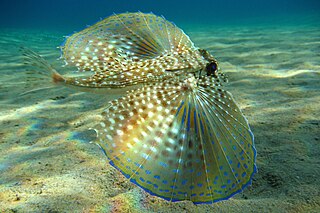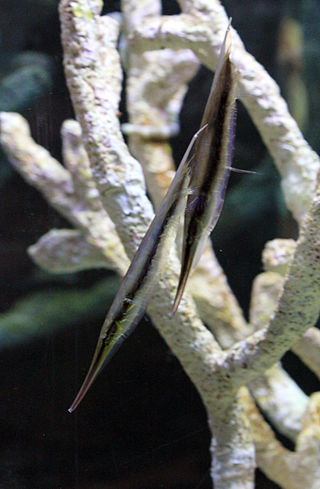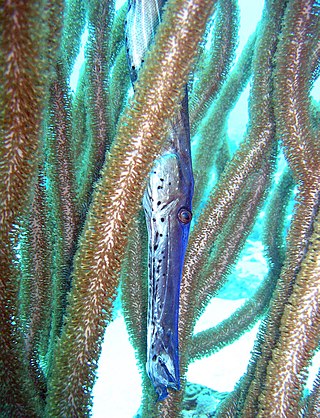
The flying gurnards are a family, Dactylopteridae, of marine fish notable for their greatly enlarged pectoral fins. As they cannot literally fly or glide in the air, an alternative name preferred by some authors is helmet gurnards. They have been regarded as the only family in the suborder Dactylopteroidei of the Scorpaeniformes but more recent molecular classifications put them in the order Syngnathiformes, in the superfamily Centriscoidea.
Ophidiiformes is an order of ray-finned fish that includes the cusk-eels, pearlfishes, viviparous brotulas, and others. Members of this order have small heads and long slender bodies. They have either smooth scales or no scales, a long dorsal fin and an anal fin that typically runs into the caudal fin. They mostly come from the tropics and subtropics, and live in both freshwater and marine habitats, including abyssal depths. They have adopted a range of feeding methods and lifestyles, including parasitism. The majority are egg-laying, but some are viviparous.

Eleotridae is a family of fish commonly known as sleeper gobies, with about 34 genera and 180 species. Most species are found in the tropical Indo-Pacific region, but there are also species in subtropical and temperate regions, warmer parts of the Americas and near the Atlantic coast in Africa. While many eleotrids pass through a planktonic stage in the sea and some spend their entire lives in the sea; as adults, the majority live in freshwater streams and brackish water. One of its genera, Caecieleotris, is troglobitic. They are especially important as predators in the freshwater stream ecosystems on oceanic islands such as New Zealand and Hawaii that otherwise lack the predatory fish families typical of nearby continents, such as catfish. Anatomically, they are similar to the gobies (Gobiidae), though unlike the majority of gobies, they do not have a pelvic sucker.

The Centriscidae are a family of fishes from the order Syngnathiformes which includes the snipefishes, shrimpfishes, and bellowfishes. A small family, consisting of only about a dozen marine species, they are of an unusual appearance, as reflected by their common names. The species in this family are restricted to relatively shallow, tropical parts of the Indo-Pacific.

The Syngnathiformes are an order of ray-finned fishes that includes the trumpetfishes and seahorses.

Macroramphosus, snipefishes or bellowfishes, is a genus of fishes found in tropical and subtropical oceans at depths down to 600 metres (2,000 ft). According to FishBase, they are part of the family Centriscidae, but Nelson (2016) split that family, in which case the genus Macroramphosus is in the family Macroramphosidae. They have long second spines on their dorsal fins and tiny mouths at the tip of their greatly elongated snouts. The bodies of snipefish are more streamlined than in the related bellowfishes. They reach a maximum length of about 20 cm (7.9 in), and are silvery or reddish in colour. They are sometimes found in large schools. This is the only genus on the monogeneric family Macroranphosidae but some authorities include the genera Centriscops and Notopogon in this family too.

Trachiniformes is an order of percomorph bony fish which is traditionally the suborder Trachinoidei of the Perciformes.

Stromateoidei is a suborder of the Scombriformes, the largest order of fish. The suborder includes the medusafishes, squaretails and driftfishes which associate with jellyfish, the latter families preying on them while the medusafish use them for protection while scavenging food scraps. In revisions of the Perciformes, the Stromateoidei have been classified as a suborder of the Scombriformes.
Dorothea's wriggler, Allomicrodesmus dorotheae, is a species of fish in the monotypic genus Allomicrodesmus which is regarded by some authorities as being in the family Xenisthmidae, the wriggler family, but in the 5th edition of Fishes of the World this is treated as a synonym of the family Eleotridae, sleeper gobies. It is 5 cm (2.0 in) in length. It is known from just two specimens, one from the Great Barrier Reef and the other from the Marshall Islands. It has been collected from a depth of around 10 m (33 ft) in a channel in a reef. The specific name honours Dorothea Bowers Schultz, the wife of Leonard Peter Schultz, who illustrated the monograph in which this species is described, although not this species.

Milyeringidae, the blind cave gobies, is a small family of gobies, in the order Gobiiformes. There are two genera and six species within the family, which is considered to be a subfamily of the Eleotridae by some authorities. Milyeringidae includes one genus (Milyeringa) restricted to caves in the North West Cape region of Australia and the other (Typhleotris) to underground water systems in Madagascar. They are all troglobitic species and have lost their eyes.

Istiophoriformes are an order of bony fish which is not fully recognized by some taxonomists, with some including the two extant families Xiphiidae and Istiophoridae, and others including the family Sphyraenidae.

Callionymiformes is an order of bony fish containing two families, the dragonets Callionymidae and the Draconettidae. In some taxonomies these families make up the suborder Callionymoidei of the wider grouping known as Perciformes, Nelson (2016) recognised the order but subsequent workers have suggested that if Callionymiformes is recognised as an order then the order Syngnathiformes is rendered paraphyletic and include Callionmyoidei within that taxon.

Scombriformes is an order of bony fish containing nine families which were classified under the suborders Scombroidei and Stromateoidei, of the wider grouping known as Perciformes, Fishes of the World, 5th ed. (2016), recognised the order but subsequent workers have suggested that Scombriformes forms part of the larger Pelagiaria clade.

Syngnathoidea is a superfamily of the pipefish order Syngnathiformes. It is divided into two families, the speciose pipefish Syngnathidae, which includes the sea horses and monotypic Solenostomidae, the ghost pipefishes, which has just five species. The superfamily occurs worldwide in tropical, subtropical and temperate seas, especially in coastal waters around rock and coral reefs and among sea weed and sea grass beds. However, there are also pelagic species of pipefish and even freshwater species. In total the superfamily comprises in excess of 50 genera and nearly 300 species.

Aulostomoidei is a suborder of the order Syngnathiformes, which also contains groups such as the seahorses, pipefishes and dragonets.

Aulostomoidei is a superfamily of the order Syngnathiformes, which also contains groups such as the seahorses, pipefishes and dragonets. It is one of two superfamilies which make up the suborder Aulostomoidei within the Syngnathiformes.

Centriscoidea is a superfamily of the suborder Aulostomoidei, part of the order which includes the sea horses, piperfishes and dragonets, the Syngnathiformes. They are chareacterised by having the 5-6 anterior vertebrae being elongated and the pelvic fin has a single spine and four rays.

Astroscopus, the electric stargazers, is a genus of stargazers, a type of percomorph fish from the family Uranoscopidae, part of the order Trachiniformes. The species in this genus are anatomically distinct Uranoscopids, being characterized by internal nares and being the only group of marine bony fish having organs which produce electricity which are derived from the extraocular muscles. They are found on the Atlantic and Pacific coasts of the Americas.
Bythitoidei is a suborder of the order Ophidiiformes, the cusk eels. They are distinguished from the other Ophidiform suborder, the Ophidioidei, by being largely viviparous.

Oxudercidae is a family of gobies which consists of four subfamilies which were formerly classified under the family Gobiidae. The family is sometimes called the Gobionellidae, but Oxudercidae has priority. The species in this family have a cosmopolitan distribution in temperate and tropical areas and are found in marine and freshwater environments, typically in inshore, euryhaline areas with silt and sand substrates.
















